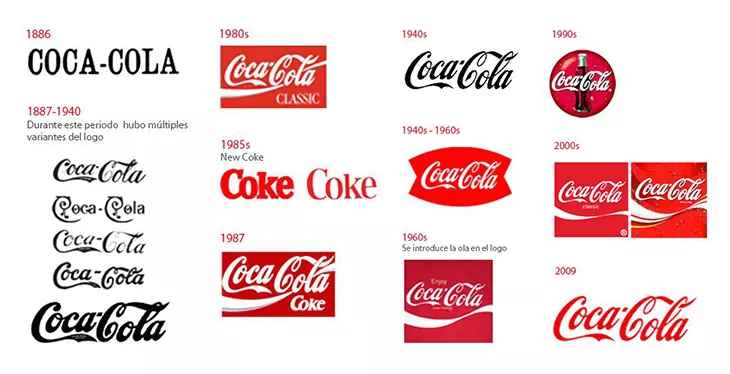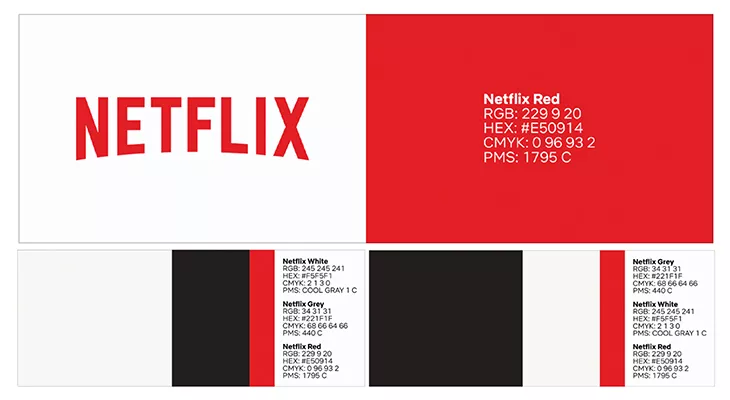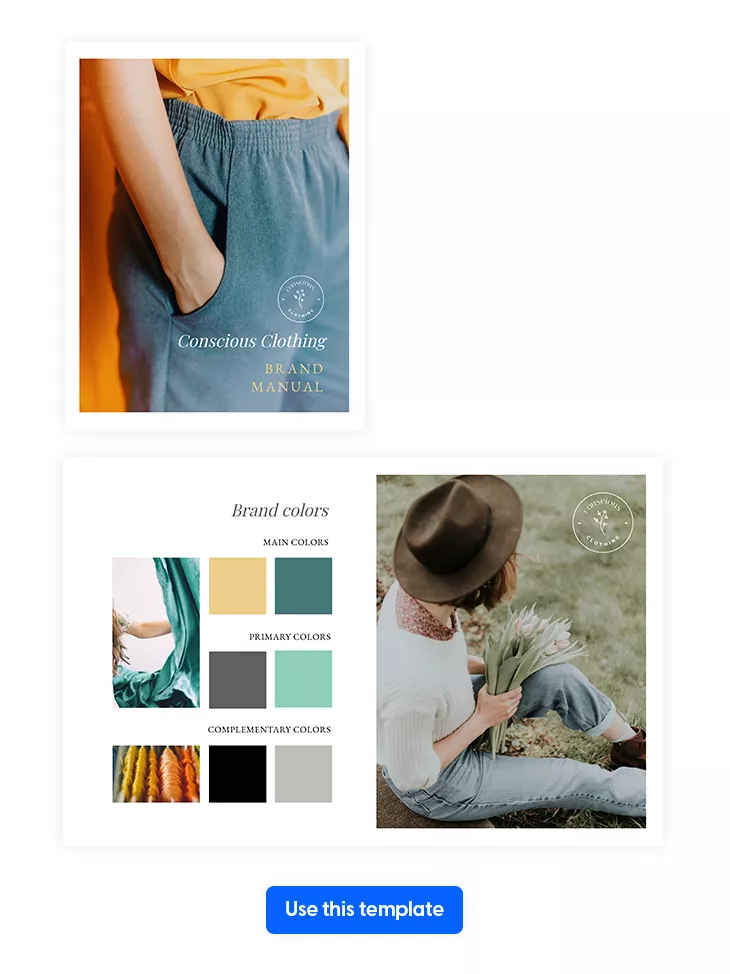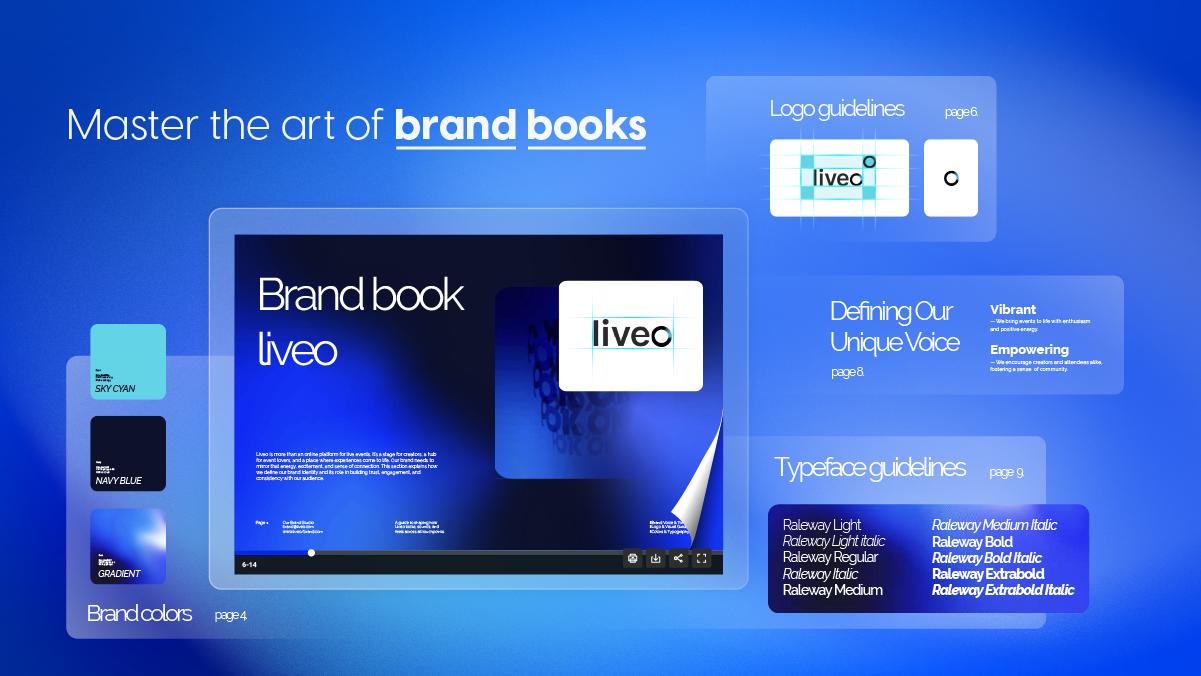How to create a brand book. Guide and examples.
Last updated: 18 November 2024
Netflix, Starbucks, Mailchimp. Do these brands sound familiar to you?
Consider how quickly you visualized these distinct brands in your mind. From their distinctive logos and carefully chosen color palettes to their visual elements and unique brand voice, each company has developed its own unmistakable market presence. It’s remarkable how effective brand identities can create immediate recognition and resonate with their target audience.
That’s why creating a brand book is one of the most valuable investments you can make in your company’s branding strategy. Think of it as your brand’s bible that outlines every detail of your brand identity, from logo usage guidelines and typography choices to tone of voice and color palette selection.
This article will walk you through every aspect of how to create a brand book, covering essential brand book components like visual identity guidelines and storytelling approaches that will easily communicate your brand’s unique character.
Whether you’re looking for brand book examples, brand book templates, or insights into brand book design best practices, this ultimate guide is packed with everything you need to establish a clear, cohesive, and powerful brand identity that will easily resonate with your audience.

What is a brand book
We can only discuss how to create a professional brand book if we know what it is. So, let’s start with the basics.
A brand book is a complete guide that defines a brand’s visual identity, messaging, and core values. It includes standards for logos, colors, fonts, and tone, ensuring consistency across all brand communications.
Acting as a strategic tool, a brand book establishes clear brand guidelines to ensure everyone, from marketing to design teams, is aligned in representing the brand consistently across all platforms. This consistency is key to building brand recognition, credibility, and customer trust in an increasingly competitive market.
While a brand book is sometimes confused with a style guide or brand guidelines document, a brand book goes beyond just defining design elements.
A brand book is also known as:
- Brand guide
- Visual identity guidelines
- Brand manual
- Style guide
- Brand identity book
- Brand toolkit
Where a style guide might focus on specific design and formatting rules for digital or print materials, and brand guidelines may offer general direction on logo usage or colors, a brand book combines all of these into a more comprehensive document. It provides design standards, mission, and core values that shape the brand’s personality and voice, connecting the brand’s look with its purpose.
Why does every brand need a brand book
The primary reason for having a brand book is consistency. When you don’t have a set of clearly established rules, everyone within your organization can make and present whatever they think might fit. As a result, they’ll express their own personality rather than show the brand’s identity.
Therefore, a brand book is invaluable for any business looking to maintain brand consistency and strengthen recognition. By setting clear guidelines on visual identity and messaging, a brand book ensures that every piece of content, from marketing campaigns to customer communications, aligns with the brand’s established look and tone.
This consistency is crucial for building credibility and fostering trust with customers; when audiences see a unified brand across channels, they’re more likely to view it as reliable and professional. That level of trust and recognition becomes a distinct competitive advantage in a crowded marketplace.
For new hires, a brand book immediately introduces the brand’s identity and values, helping them align with the company’s messaging from day one. By empowering teams to communicate with one voice, a brand book improves collaboration and ensures that every interaction with the brand reinforces its identity.
To summarize the above, here’s why brand books are essential and what benefits they could bring to your business.
Benefits of a brand book:
- Defines brand identity clearly
- Ensures brand consistency and strengthens brand recognition
- Enhances credibility and customer trust
- Serves as a training tool for new team members
- Boosts brand loyalty and recognition
- Secures all departments communicate a unified message
- Improves collaboration between designers, marketers, and content creators
- Drives higher revenue potential
Creating a brand book sets a foundation for long-term brand success, supporting both internal teams and external brand perception.
What should a brand book include?
Now that you understand what a brand book is and what benefits it brings to your business, let’s see what exactly a brand book should include.
Here, I’ll offer you a step-by-step guide to make it even easier for you.
A brand book should include:
- The About section that details the brand’s mission, vision, core values, target audience
- Visual guidelines such as logo usage guidelines, color palette codes, typography rules
- Communication and content guidelines like tone of voice instructions, grammar and formatting rules, email signature, and social media guidelines
Let’s talk about each one individually.
1. The About section
Usually, the About section is placed right at the beginning of a brand book as it tells the reader more about the brand, what it does, and what it stands for. It’s also a good place to start revealing your brand story and let the world better understand the core of your business. So, make a compelling brand story that people can quickly relate to.
This section can be short or long, depending on your intentions and how thorough you want your manual. This is the one chapter that’s skipped the most because the mission and values are usually presented in a very dull, corporate-style way.
But it doesn’t have to be that way. In fact, in Flipsnack, you can easily create an engaging brand book that will easily entertain anyone who reads it. For example, instead of adding big chunks of text, you can use interactive elements such as videos, photo slideshow, captions, links, and more.
The About section in a brand book contains details such as:
- Mission
- Vision
- Core values
- Target audience
- Brand persona
Defining your brand’s mission, vision, and core values is foundational in any brand book, as these elements set the tone for every aspect of the brand’s identity. The mission captures what your company stands for and its primary purpose, while the vision points to the long-term goals and impact you aim to achieve.
These principles and core values serve as the “why” behind your brand, providing a clear direction for all branding decisions. By establishing a solid foundation, your mission, vision, and values guide everything from messaging and tone to design and customer interactions, ensuring a consistent, purposeful brand experience that resonates with employees and customers. Partnering with brand identity design services can help translate these core values ensuring a consistent, purposeful brand experience that resonates with employees and customers.
Company’s mission statement
The first thing you need to add to your brand book is a mission statement. Mission statements should be clearly established and generally available even for years to pass. It’s good practice to tell people what your company does and what the purpose of your product or service is, the reasons you’re doing it, and how all of these impact the world. Mission statements also help future employees and even investors see if they would fit in your company or resonate with it.
A mission statement should:
- Communicate your company’s purpose
- Tell the world your company’s objectives
- Show the way you serve your audience
Setting the mission statement right from the beginning tells the difference between you and your competitors. So, write a mission statement that reflects your company at its best.
Vision and core values
While the mission statement should remain consistent throughout the years, in the vision statement, you can express your company’s present and future plans. It can also be changed with time and growth.
Having a solid vision statement can serve as a foundation force for all your future business decisions. It also portrays where the company wants to be and what it wants to become. Don’t forget to also add your company’s core values, so people know what aspects your company insists on.
Core values, they are all about your company’s beliefs and what it stands for. Core values are helpful as they set the path for achieving success and guide the overall behavior within the company.
Here are the core values that we practice at Flipsnack. Take a look and maybe find some inspiration for your company.

Target audience
Knowing your target audience is a vital step in gaining a company’s success. But, first, you have to know exactly for whom you create a product or service. What kind of buyer persona will buy your product? Between which ages? Are they young?
It’s helpful to know this as you can narrow down the audience and reach leads that will be actually interested in buying your product or service.
Brand persona
Having a brand persona is one of the critical elements that help you set the tone for your brand’s messaging. If your brand has a more friendly personality or uses a more formal approach, write that in the brand book and let people know what to expect from you.
The brand persona concept is how you want to present your company to the world. It’s about what people will notice when they interact with your brand’s platforms. From the goals, products, or services you offer to the social media content and even the customer relationships you develop.
However, don’t mislead the brand persona with the buyer persona. These are two completely different concepts. The buyer persona concept refers to the people your company wants to talk to. Basically, it implies having a fictional representation of the ideal customer for your company.
2. Visual guidelines
In this fast-paced digital world, the first thing people notice is visuals. Be it through an image, video, GIF, color scheme, or everything in between, these are the elements of a brand that instantly catch the attention.
Key elements of a brand book visual guidelines typically include:
- Logo usage guidelines: color, placement, variations, size and proportions
- Color palette: HEX, RGB, and CMYK codes, primary and secondary brand colors
- Typography rules outlining preferred fonts and styling: font types, sizes, and use cases
- Imagery: styles and themes that reflect the brand’s personality
- Tagline: catchphrase or slogan
- Other graphics: icons, patterns, textures
Visual guidelines can help you be consistent in all the design elements you use for digital and print communication. For instance, choosing a representative color scheme like Starbucks has used – green and black design elements on their communication channels – will let people easily recognize you from all the others anywhere in this world.
Setting thorough visual guidelines will help not only your design team but also anyone within the company. From the social media manager to the content marketer, each team member will know exactly what color scheme, typography, and images to use in their work. A digital asset management tool like Dash gives a home to all these visual elements so you can easily share them with your teams and deploy them to your social channels.
Starbucks integrated visual guidelines in all its communication channels. Starting from the logo, colors, and typography to illustrations and photos.

They stay true to their brand identity and try to show it in everything they do. From the social media platforms to the packaging and everything in between, it all says loud and clear: Starbucks!
3. Communication and content guidelines
Brand voice and tone are critical elements in a brand book that help define how to communicate consistently and authentically. The brand voice represents the unique personality of your business, be it professional or playful, and this should stay consistent across all communications channels. Tone, however, adapts to different scenarios, adjusting the brand’s voice to fit the context. For instance, a software company may use an enthusiastic, encouraging tone in product announcements but adopt a calm, reassuring tone in support responses.
Also, specific phrases and language styles should be outlined in the brand book to help team members express the brand’s personality effectively; for example, using friendly, direct language over jargon or favoring active, engaging phrases like “Let’s get started” rather than “Proceed.”
This is a list of all the elements that are part of communication guidelines:
- Language: what is the primary language of your brand: friendly/professional
- Grammar and formatting: abbreviations, numbers, capitalization, acronyms, times, and titles
- Readability: intricate sentences or short, simple ones
- Style: Technical/ non-technical; formal/casual/slang
- Tone of voice: (logical/emotional; serious/humorous, etc.)
- Email: email structure, email signature
- Editorial style guide: guidelines, formatting, and structure for blog posts
- Social Media: purpose, frequency of posting, and post types for each social channel
Communication guidelines are essential when you want to have a successful and professional company. So, establish the communication guidelines you want to use with your team, from the in-house, internal communication to the marketing and promotional messaging.
The do’s and don’ts of a brand book
When creating a brand book, it’s important to avoid common pitfalls that can limit its effectiveness, such as being overly restrictive, unclear, or inconsistently applied. A brand book that’s too rigid may stifle creativity, making it hard for teams to adapt guidelines to various platforms or evolving brand needs.
On the other hand, if guidelines are too vague, team members may struggle with interpretation, leading to inconsistent application across channels. To sidestep these issues, focus on clarity by providing specific, flexible guidelines and practical examples, making it easy for different departments to apply the brand standards. Regular updates and training sessions can also help ensure alignment and consistency as your brand evolves, allowing your brand book to be a helpful, adaptable resource for every team member.
It’s recommended that you plan meetings with all of them when creating a brand book so each department can prepare their piece of content that contributes to the making.
Also, the project needs to be coordinated by someone who helped shape the brand’s identity and has enough authority to decide and impose them. The entire brand book is pointless if employees don’t know about it or don’t respect it.
How to create a brand book – Step-by-step guide
As you’ve seen, creating a great brand identity book involves a clear, structured approach that captures and communicates every essential aspect of the brand. To make it even easier for you, I’ve prepared a step-by-step guide that you can easily use when creating your brand book.
Here are some important steps to follow for brand book creation:
Step 1: Define the brand’s core values
Begin by defining the core elements of your brand—its goals, values, and personality. These foundational aspects will shape every guideline in the brand book, providing a clear sense of what your brand stands for and how it should be perceived.
Outline how the brand communicates, including voice and tone, language style, and personality. Is the tone formal or casual, friendly or authoritative? Provide examples of language and phrases that align with the brand’s personality and offer guidance on how to adapt the tone for different contexts or audiences.
Step 2: Establish visual elements
Include standards for logos, typography, and color palette is crucial to maintaining a unified brand identity. Add high-resolution versions of the primary and secondary logos, noting size variations and placements.
Specify how the logo should be used across different platforms and mediums. Include do’s and don’ts for resizing, spacing, color variations, and background settings. Make sure to address improper logo usage and provide clear guidelines on maintaining brand integrity in all applications.
Also, detail the brand’s color palette, specifying primary and secondary colors with their HEX, RGB, and CMYK codes for consistency. And define typography, including the primary and secondary fonts, styles, and any specific formatting rules for headers, body text, and captions.
Step 3: Create guidelines for imagery and graphic elements
Outline the visual style of imagery to be used, such as preferred types of photos, image treatments, filters, and themes. Provide examples of acceptable images and define any restrictions to keep imagery consistent with the brand’s tone and message.
If the brand uses specific icons, graphics, or patterns, specify their intended use. Outline size, color, spacing, and any rules for combining them with other brand elements.
These design elements should enhance brand recognition and add to the visual cohesiveness of the brand.
Step 4: Set consistent guidelines for all platforms
To maintain a consistent brand voice and look across different platforms, detail specific usage rules for social media, websites, print, and other media. These guidelines ensure that whether your brand appears online or offline, it communicates the same message, tone, and visual style, reinforcing brand recognition.
Offer visual examples of both correct and incorrect usage of brand elements to minimize potential errors. This section helps reinforce guidelines and allows team members to see precisely how the brand should (and shouldn’t) appear.
Step 5: Create an easy-to-follow structure and update regularly
Ensure the brand book is well-organized, with sections that are easy to navigate. Include a table of contents, section dividers, and plenty of visual examples to make the document user-friendly.
Get feedback from different departments to ensure the brand book meets the needs of all stakeholders. This cross-departmental input helps adjust the guidelines, ensuring they are practical and effective. Once finalized, the brand book becomes a living document.
However, brand identity evolves over time, so it’s essential to keep the brand book updated to reflect any changes in brand positioning, messaging, or design. Consider creating a digital version of the brand book to make it easily accessible and editable.
And ensure that everyone on the team can quickly reference and download the latest brand assets, templates, and guidelines from a central location. Don’t forget to schedule periodic reviews to ensure the brand book remains relevant, accurate, and in line with the brand’s evolving goals.
Step 6: Embrace the power of digital with interactive brand books
Digital brand books streamline brand management, improving both consistency and efficiency across teams. They also have multi-platform compatibility, which basically means that they can be easily accessed from various platforms, such as desktops, tablets, and mobile devices. This allows seamless sharing, no matter where team members are located.
Likewise, the interactive elements, such as embedded videos, photo slideshows, clickable links, and feedback forms, make the guidelines more engaging and easier to follow. Editing capabilities ensure that the brand book can be updated instantly as your brand evolves, so everyone always has the latest guidelines at their fingertips. You can also build your brand book by using a premade template design. These are fully customizable and make sure that your end result will be a sleek and polished brand book design.
How to design a brand book + Inspiring brand book examples
Creating a brand book document is one thing. Designing a brand book is a whole different task to do. When it comes to the design part, you must ensure that all the guidelines you’ve previously established with your team will be clearly communicated throughout the entire design of the brand book.
So, let’s cover some brand book design tips.
We’ll check some examples from big companies that have branding guidelines that are well established.
1. Provide logo usage guidelines
The first and most important thing you should add to your brand book design is the logo. The logo represents the company’s visual identity, so it’s essential to have one that really signifies your brand. I know it’s quite challenging to have a distinctive logo. You can always hire professionals who know how to best design and reflect your brand through a remarkable logo. Also, include all the approved alterations of your logo in the brand book and add information on usage.
Even if your logo can be used in white, black, or red, people will know that those still are the variations approved by the brand and that it’s safe to use it that way.
Let’s take a look at the Coke logo.

Just like Coca-Cola’s logo has three variations, you can notice that the logo also suffered some changes over time. But it’s important to also add them in the brand book and let people see how you changed and improved. There’s nothing wrong with having your logo adapt to the present times. Actually, it shows people that you care and try to do the best for your brand’s growth consistently. Don’t change it too often, though. You don’t want to affect your brand’s recognition and credibility.
2. Present the brand’s unique color scheme
The color scheme you use will help shape the entire visual aspect of your brand book design. Keeping your color palette consistent will also maintain the brand’s recognition intact. Likewise, it’s essential to add the color palette to let the collaborators, customers, and employees know the core colors of your brand.
So, clearly define your brand’s color scheme or palette and specify the primary and secondary colors, HEX codes, RGB values, and CMYK color codes. You can also add examples of how to use your brand’s color scheme avoid having misleading color associations with your brand.
In the image below, you can see how Netflix and Spotify set their color guidelines.


You can play around with different colors for some ad campaigns, for instance. But try to stick to the approved variations and make sure people will easily correlate them with your brand.
Here’s an example of how the Flipsnack team decided on the color scheme for our 10th anniversary. We did a brand redesign to make the colors more true to the brand and how we want to communicate with our audiences. Now, we use these colors in all our communication channels.

3. Add detailed typography rules
Another important aspect to add to your brand book design the font selection. Typography reflects your brand’s personality and will immediately tell people if you’re on the more playful, friendly side or if you want to keep things professional and follow a more formal approach.
Either way, add the details about the font selection and stick to 2-3 fonts your brand uses the most. Add the name of the font and the sizes you usually go for.
Add typography details in your brand book like:
- Font name – examples: Arial, Roboto, Times New Roman
- Font size – for the headers, subheadings, and paragraphs
- Font weights – light, italic, bold
Here is an image example of how Starbucks included its typography guidelines in the brand book.

It’s also good practice to add a little description about the fonts you use. Doing this lets others understand the purpose of the typography style you use and how you want to communicate the message.
This brings me to my next point.
4. Elaborate your brand’s tone of voice
Your brand’s tone of voice is a key element you need to add to your brand book. It shows the world your brand’s personality, and you can reveal once again the communication style you want to have with your audience, informal or natural language between friends or even a formal, professional tone. It’s important to add these details to your brand book.
Keep in mind that you should maintain the tone of your brand throughout all the communication channels you use. Let the tone of voice speak your intentions.
Netflix, for instance, has an informal tone of voice, mimicking the language friends would use on social media platforms. They want to be fun, engaging, and entertaining, which suits their brand best. On the other hand, Apple has a more confident tone of voice, reflecting the expertise, quality, and trust – which is appropriate for a software company like them.
5. Offer imagery and video style guidelines
Images and videos are hands down the most important aspect to add to your brand book. As we live in a digital world, these two elements can trigger instant brand recognition and help in the buying decision process.
It’s essential to specify the photographic details used in your company as every advertising campaign might imply different collaborators. They’ll know exactly what details to look for, keeping the style consistent throughout the entire shooting.
Include examples so people will know how to best reflect your brand’s personality through images and videos.
Here’s a video with some other helpful tips for designing a brand book.
How to make a brand book in Flipsnack
Now it’s time to learn how to create a brand book in Flipsnack. You have three options available. The first is to upload your PDF brand book document to Flipsnack and transform it into a flipbook with a 3D page flip effect. The second is to use a brand book template from our collection, and the third one is to start the design process from scratch.
What Flipsnack does to your brand book’s design is the added 3D page flip effect. Not only that, but we offer a plethora of interactive elements to help you design a visually appealing publication, like videos, photo slideshows, captions, links, charts, contact forms, questions, and lots of other branding features.
With Flipsnack, it’s easy to enforce branding guidelines and ensure that they are respected. Moreover, you can enable your employees to collaborate and assign roles and permission for a smooth workflow process. Empower them to finish the brand book design with ease and pleasure, as everything on our platform happens with a simple drag-and-drop. There’s no need for professional tech-savvy design skills.
So, let’s see how you can stand out among your competitors and surpass your reader’s expectations with a fantastic brand book design.
Create a brand book in Flipsnack:
- Prepare all the discussed guideline details, from the mission statement to the logo, color palette, and images.
- Organize the layout of the pages and save your document as a PDF.
- Upload your PDF document to Flipsnack or start the design process with a brand book template from our wide collection. Our Design Studio tool. It’s intuitive and easy to use.
- Add interactive elements like videos, photo slideshows, and captions and make your brand book engaging.
- Save the document and embed it on your website for easy access. You can also share your digital brand book through a link publicly or privately.
Here’s a brand book template that you can start with.

Conclusion
Creating a well-defined brand book is essential for any business aiming to establish a consistent, professional brand presence. By investing time in developing a comprehensive brand book, companies ensure that every interaction reflects the brand’s identity, values, and messaging across all platforms.

This consistency not only strengthens brand recognition but also builds trust with audiences as they come to recognize and rely on the brand’s familiar tone, look, and messaging. A strong brand book provides a foundation that aligns teams, improves collaboration, and guides future brand growth. Taking the time to create a detailed brand book today will lead to a more cohesive and impactful brand tomorrow.
FAQs
A brand book is a comprehensive guide that defines a brand’s visual identity, messaging, and core values, while a style guide focuses more narrowly on specific formatting rules for content creation, such as font usage, color codes, and design elements. Think of the brand book as the “why” and “how” of your brand, whereas the style guide is more about the technical “what” for content consistency.
Small businesses benefit from a brand book by establishing a clear, professional identity that builds customer trust and recognition. It helps smaller teams maintain consistency in messaging and visuals, which is crucial for standing out in competitive markets. A brand book ensures every interaction reflects the brand’s values, even with limited resources.
A brand book improves team alignment by providing clear guidelines for all departments, ensuring everyone understands and represents the brand in a unified way. With a brand book, designers, marketers, and customer service teams all follow the same principles, creating a seamless brand experience for customers.
A brand book should be reviewed annually or whenever the brand undergoes significant changes, such as a rebranding or shift in target audience. Regular updates keep the brand book relevant and ensure it reflects the current identity and goals of the business.




Excellent!!! Incredibly useful!
Thanks for this. Very helpful for me right now. Thank you.
Great content. Your post is very informative and useful. Thanks for sharing this amazing post about how to create a brand book guide and examples. Good job.
Great content. Thank you for sharing the information. I got comprehensive knowledge about the brand book.
Wow this is very informative. Thank’s for sharing
Well written article! Thank you so much! Learnt so much. I’m just about to create our first-ever brand book and this article will help me a lot!
simply said, clear, informative! thanks a million.
Hi , I have read your blog, it’s very amazing, it has helped me to get a knowledge about blogs & I will implement this on my website as well. Please continue to provide knowledge with your blogs.
We’re glad you found this useful!